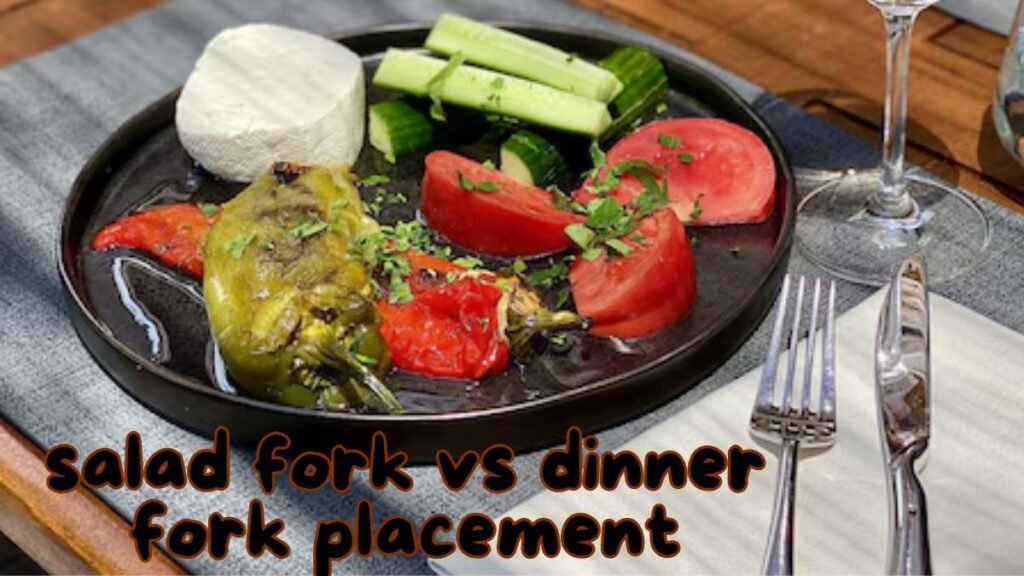Whether you are hosting a formal dinner or attending a fine dining event, understanding the proper use of different utensils is essential. One of the most common questions that arise is about the salad fork vs dinner fork. These two types of forks may appear similar, but they serve different purposes and have distinct characteristics that set them apart. In this article, we’ll explore the differences between these forks, their appropriate use, and why knowing the distinction matters.
What is a Salad Fork?
A salad fork is a specialized utensil primarily used for eating salads. Generally, it is smaller in size, measuring around 6 to 7 inches in length. The tines of a salad fork are typically broader and sometimes slightly shorter, with a slight curve designed to efficiently grasp leafy greens, vegetables, and salad toppings. Some salad forks may even have a broader left tine to aid in cutting through lettuce or other salad ingredients without needing a knife.
This unique design allows for better handling of lighter and softer foods typically served during the salad course, providing an enhanced dining experience by making it easier to pick up small, delicate ingredients.
What is a Dinner Fork?
A dinner fork, on the other hand, is a more versatile utensil that is used for the main course of a meal. It is usually larger, measuring about 7 to 8 inches in length. The tines of a dinner fork are longer and more evenly spaced, making them suitable for a wide range of foods, from meats to vegetables.
The dinner fork handles foods of varying textures and densities with ease. As the “workhorse” of the table, it efficiently manages everything from tender steak to soft pasta. In most formal table settings, you will find the dinner fork placed closest to the plate, highlighting its primary role during the main course.
Key Differences Between a Salad Fork and a Dinner Fork
While both forks are essential to a well-set table, their differences extend beyond just size. Here are the primary distinctions between a salad fork and a dinner fork:
- Size and Length: The most noticeable difference is the size. A salad fork is smaller than a dinner fork, making it easy to identify in a formal table setting.
- Tine Design: Salad forks have broader, flatter tines that are sometimes shorter and slightly curved to handle lighter, more delicate foods like salad greens. Dinner forks have longer, straighter tines suited for various textures, including meats and denser foods.
- Placement in a Table Setting: The salad fork is placed to the left of the dinner fork. This order follows the sequence of the meal, where the salad course usually precedes the main course.
- The salad fork serves specifically for the salad course, while the dinner fork offers versatility and is used throughout the main course.
How to Properly Use a Salad Fork

Using a salad fork correctly is simple once you understand its design. During a multi-course meal, the salad fork is used primarily for eating salads served before the main course. Here’s how to use it properly:
- Hold the Fork Correctly: If you are using a knife, hold the salad fork in your left hand. If using the fork alone, hold it in your right hand.
- Utilize the Design: Use the broader, curved tines to scoop up leafy greens and other salad ingredients. The slight curve helps secure loose items, while the broader left tine can assist in cutting through larger pieces.
- Follow Dining Etiquette: When finished with your salad, place the fork on your plate with the tines facing upwards, signaling to the server that you are done.
How to Properly Use a Dinner Fork
The dinner fork is held similarly to the salad fork, but its use is more comprehensive. Follow these guidelines to make the most of your dining experience:
- Holding Technique: When using a knife, hold the dinner fork in your left hand. If the fork is used alone, it should be held in the right hand.
- Adapt to Different Foods: Use the dinner fork to manage various foods, from cutting and lifting a piece of steak to twirling pasta. The longer, straighter tines offer versatility for various types of food.
- Table Etiquette: After finishing the main course, place the fork on your plate in the 4 o’clock position with the tines facing up.
Why Does the Difference Between Salad Fork and Dinner Fork Matter?
You may wonder, “Why does it matter which fork I use?” Proper use of utensils reflects your understanding of dining etiquette, an essential part of formal and even casual dining experiences. Using the correct fork shows that you respect the meal, the host, and the cultural traditions associated with formal dining.
Moreover, using the appropriate fork enhances the dining experience by making it easier to handle the food as intended by the chef. The design of each fork is tailored to the course it accompanies, allowing you to fully enjoy the textures, flavors, and presentation of each dish.
History of the Salad Fork and Dinner Fork
Forks as dining utensils have a long and storied history. They were first used in ancient Persia and gradually made their way to Europe by the 11th century. However, it wasn’t until the 18th century that specialized forks, like the salad fork and dinner fork, became common in formal dining settings. The rise of elaborate multi-course meals in Europe drove the need for various types of utensils, including forks designed specifically for different courses.
Today, the salad fork vs dinner fork distinction remains a key aspect of Western dining etiquette, symbolizing attention to detail and respect for culinary traditions.
How to Set a Table with a Salad Fork and Dinner Fork
Proper table setting is an art that can elevate any dining experience. Here’s how to set a table correctly using both a salad fork and a dinner fork:
- Step 1: Start with the Plates: Place the dinner plate in the center of the setting.
- Step 2: Position the Dinner Fork: Place the dinner fork to the left of the dinner plate.
- Step 3: Position the Salad Fork: Place the salad fork to the left of the dinner fork. This positioning reflects the order in which the utensils will be used, from the outside in.
- Step 4: Arrange Other Utensils: Continue setting the table with knives, spoons, glasses, and napkins as needed.
Choosing the Right Fork for Different Dining Situations
While understanding the difference between a salad fork and a dinner fork is important for formal dining, there are other situations where the choice of fork may vary:
- Casual Dining at Home: For informal meals, using just a dinner fork for all courses is common and acceptable.
- Buffet-Style Events: Often, only one type of fork is provided for all dishes. Use the provided fork for all courses.
- Fine Dining and Formal Events: Pay close attention to the placement of forks on the table. Use the forks in the order they are laid out, starting from the outermost fork.
FAQs
What is the purpose of a salad fork?
A salad fork is designed specifically for eating salads. Its smaller size and broader tines make it ideal for gripping delicate salad ingredients.
Can I use a dinner fork instead of a salad fork?
You can use a dinner fork for salads in casual dining settings, but in formal dining, you should use the correct utensil to follow proper etiquette.
Why does a salad fork have a curved tine?
The curved tine on a salad fork helps to grip and cut through leafy greens and other soft salad ingredients without the need for a knife.
Where should you place the salad fork in a table setting?
In a formal setting, place the salad fork to the left of the dinner fork, indicating its use during the earlier salad course.
How do I know which fork to use first?
Follow the “outside-in” rule: start with the outermost fork and work your way inward with each course.
Are there other types of forks used in dining?
Yes, there are several types of forks, including dessert forks, fish forks, and oyster forks, each designed for specific courses.
Conclusion
Understanding the difference between a salad fork and a dinner fork may seem like a small detail, but it plays a significant role in formal dining etiquette. By mastering these distinctions, you enhance your dining experience and show respect for the tradition and customs of formal meals. For more tips on dining etiquette and table settings, visit Chic Style Hubs and explore our comprehensive guides to elevating your hosting skills and culinary knowledge.











